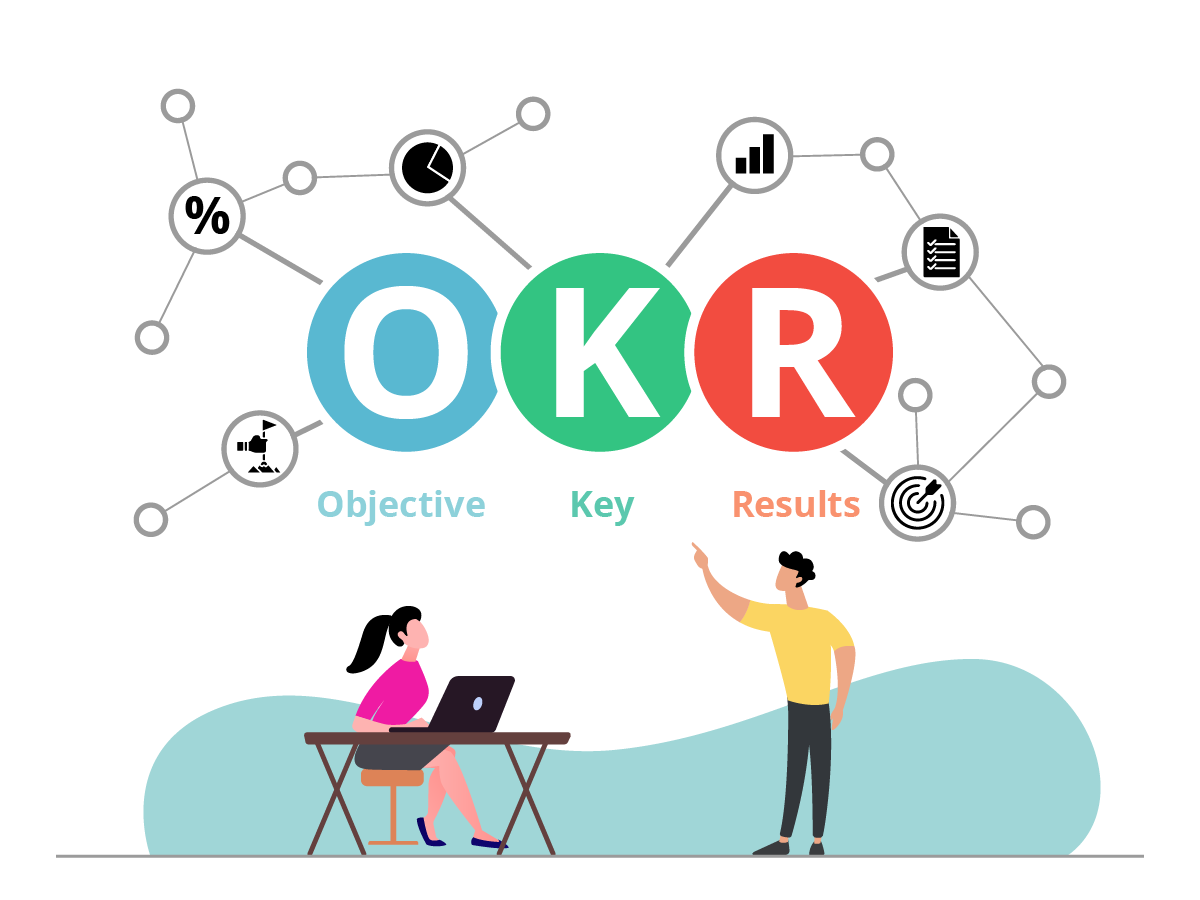Understanding Sales OKRs Their Importance and Benefits
Let's begin with a brief history of objectives and key results (OKR): You may remember this acronym since the CEOs of two technological behemoths, Intel and Google, have credited the OKR framework for their business operations. Because of its proven record of success, this system has been implemented by numerous Silicon Valley firms as well as globally.
Using OKRs is an effective method for setting, tracking, and measuring goals on a regular (typically quarterly) basis. The framework of the process fosters alignment and engagement around these aims. In short, everyone understands their goal and works at a rapid, constant pace to achieve it.

What is an Objective and Key Result (OKR)?
The OKR formula is to define an aim, which is "what I want to accomplish," and key outcomes, which determine how to achieve it. Thus, with OKR, a goal is more than simply what you want to do; it must also contain a method for measuring success. OKR, which is widely used by IT organizations, may help businesses remain on track in a fast-paced, ever-changing market while also promoting innovation.
In today's competitive landscape, effectively utilizing OKRs can pave the way for impressive business outcomes. By setting quantifiable key results and aligning objectives with company goals, businesses do not merely sustain but thrive. To further aid organizations in achieving their ambitions, consider strategies that emphatically drive performance and boost business metrics. Among various methods to enhance your organization’s outcomes is understanding your audience, optimizing the sales funnel using technology, and refining customer experiences to significantly increase sales.
OKRs support a goal or vision and should be quantifiable, adaptable, transparent, and aspirational. They are normally set by leadership and are never linked to salary or performance evaluations. Finally, OKRs enable firms to establish lofty targets and then focus on attaining them over a business quarter.
How are OKRs used?
The most effective OKRs provide team members with clarity on what they hope to achieve as well as how they plan to assess milestones along the way. OKRs are meant to give a framework for groups rather than individuals, and the process is designed to guarantee that all sectors of the organization are working toward the same goals. OKRs consist of two components: objectives and key results. An Objective is often followed by two to three Key Results statements.
Objectives are distinct, well-defined goals that will have a significant influence on the firm. They should be tough yet attainable, as well as consistent with an organization's strategic goals.
Key Results are used to evaluate or monitor an objective's progress toward reaching the goal. Key results are outcomes that demonstrate if a goal was met or an aim was completed.
The written formula for an OKR (Objective and Key Results) typically follows this structure:
Objective: A specific, motivating aim you'd like to accomplish.
Key Results: Measurable, precise results that show the goal is being approached.
The formula looks like this:
Goal: [What you hope to accomplish]
Important Findings:
1. [First measurable outcome]
2. [Enduring Outcome]
3. [Taxable outcome]

What is the difference between OKRs and KPIs?
Now that you have learned about OKRs, you are probably interested in the difference between Objectives and Key Results (OKRs) and Key Performance Indicators (KPIs). There are two distinct sorts of objectives, each with a different purpose. Let's take a deeper look at what differentiates them:
a. KPIs enable you to keep the lights on. They are a performance measurement instrument that assesses the success, output, quantity, and quality of a continuous process or activity. These procedures or actions are often already in place in your teams and organization.
b. In contrast, OKRs bridge the gap between goal and reality. They assist you in challenging the current quo and venturing into new, often unfamiliar terrain. If you have a large ambition that you want your company or team(s) to realize in the future, you will need OKRs to get there.
Despite being separate sorts of goals, OKRs and KPIs complement one another. Combining the two adds significant value since it gives you all the tools you need to manage the health of your whole business.
Imagine that some companies are having problems acquiring repeat clients.
a. KPI: Increase recurring consumers by 50%. This might be accomplished by providing a discount to recurring consumers. The corporation would meet its objectives, but the results would only last as long as the agreement was offered.
b. OKR Goal: Encourage repeat consumers.
c. Key Results: Increase client satisfaction by 20 percent.
Improve communication with your present clientele, implementing sophisticated techniques like monitoring calls or a call queuing system. Request comments after tasks are done. These are aims that work together to increase efficiency.
They are also organized, so the team knows what to give preference to. The outcomes stimulate communication, so the teams are developing new abilities, such as how to use the ideal talk-listen ratio. Even if customer satisfaction improves by only 15%, the existing results are sustainable and allow for future expansion.

The top 5 reasons why you should start with OKRs now
Reason 1: OKRs give the essential clarity
Does your firm operate well? What advantages do you provide for our customers? Are you doing the right thing? Tens of thousands of firms throughout the world have posed similar questions.
The OKR technique requires firms to establish their vision and purpose since the foundation for working with OKRs is a clear and understood mission statement pyramid. Once they have been identified, the organization's actions may be aligned accordingly. The more accurately the plan is established, the better the operational outcomes will be.
Practically every established organization indeed has a Mission Statement. Quick quiz: Without checking, can you portray your company's vision? Is your understanding of the company's vision consistent with that of your team? These questions must be resolved so that everybody in the company has proper clarity and is doing the proper things – this is particularly true, but not only, in the current scenario.
Reason 2: OKRs make an area for creativity
OKRs enable staff to focus completely on a single aim. They understand what is vital to the organization at the time and may focus their time on brainstorming fresh and imaginative approaches to completing the assignment.
This might result in a significant breakthrough in your sector. When numerous components are vying for an employee's attention, it is difficult to remain entirely focused on one work. OKRs, a goal management tool, allows your team to analyze how they are presently doing a job and query how the process might be improved.
Reason 3: OKRs help the team adjust to changes
Establishing short-term OKRs in your firm and continuously evaluating them helps your team pivot. Issues identified during weekly OKR check-ins enable teams to make the required modifications to identify solutions before they escalate into larger difficulties. Otherwise, your company may go a full quarter or year before resolving a problem that could have raised revenue by 20%.
Reason 4: OKRs promote alignment throughout the company
Leadership often produces corporate OKR sets, which are then linked with the OKRs of departments and individual teams. This provides two essential benefits: a strong sense of purpose, as communicated via the corporate vision and underlying leadership OKRs, keeps all teams and workers pushing in the same direction.
Every team member, whether a developer, product manager, sales representative, or human resources manager, must understand how they contribute to the objectives and key results.
The second, less evident benefit is that OKRs are co-created by teams and departments, fostering cross-functional collaboration. Sharing OKRs not only promotes teamwork but also reduces interdependence and harmonizes competing projects. Based on the Harvard Business Review, employees who are well-aligned are more than twice as likely to be top achievers as those who are not.
Reason 5: OKRs allow you to track and assess progress
Track your development regularly – weekly is excellent. Keep track of your progress towards your Key Results. There are several tools available to aid with this. Smaller businesses can use Google Sheets or a comparable tool.
You may view our official ones here. Some team members also like hosting a weekly or monthly all-office WINS meeting where they may update everyone on their OKRs or offer shout-outs.

How to write OKRs: What Is a good OKR structure?
Well-written OKRs provide you with a sense of direction, allow you to focus on what is genuinely essential, and help you prioritize your tasks. They also make it evident to everyone in the company what a team or person is working on at any given time - openness is key!
And, let's be honest, it will be a lot easier for your firm to implement OKRs if they are configured correctly. Well-written OKRs indicate a well-defined route to accomplishing them.
You will be confident in not just where you want to go, but also how to get there. Furthermore, you will be able to track the relevant parameters, allowing for improved decision-making.
How to write Objectives
Objectives should be motivating, memorable, and qualitative. Objectives are what you want to accomplish and should reflect your aim, desire, and aspirations. When developing objectives, consider whether they elicit emotion.
You want the team to see the target and say, "Yeah, I want to help get that done." Typically, targets are presented monthly or quarterly. We propose no more than one to three objectives per team every quarter, but the precise number will depend on your organization's needs.
How to Write Key Results
To track progress toward your goal, specify quantifiable key results. When constructing OKRs, use a metric to convey the main findings unambiguously. Defining important results using metrics with numbers makes it simple to express progress toward your goal in a relevant manner.
Furthermore, crucial outcomes should be outcome-focused rather than task-based, reflecting the ideal outcome required to complete the target – with no limits on how it is done.
The Top 3 Common OKR Mistakes
1. Setting unachievable goals
If your goals are set excessively high, not only will they demotivate employees if they are not met, but they may also force teams to take corners and compromise quality. Misinterpreting stretch objectives can cause stress, overwork, and long-term harm.
2. Creating chores, not objectives
Teams unfamiliar with OKRs sometimes construct objectives with important results that are, in reality, merely chores. OKRs are not a to-do list, though. They serve as a foundation for most of the work being done, providing purpose and direction. A task lacks effect and might be worthless without an aim to propel it forward.
3. Taking a top-down approach
It is a prevalent misconception that objectives and important achievements should be established from the top down, with people progressing to higher-level targets. If you do not include teams in corporate strategy, you risk employees getting alienated from their jobs and unmotivated due to a lack of autonomy.
Furthermore, as a leader, you are unlikely to be involved in the specifics of execution, which means you may lack expertise in determining which critical results and projects will have the most impact.
The secret weapon of success: Use the power of OKRs today
To summarize, OKRs are an effective framework for driving strategic alignment, increasing responsibility, and focusing resources on what is most important. When teams identify and agree on ambitious Objectives and quantifiable Key Results, growth becomes a team sport.



